LED fresnel lights offer a very good alternative to traditional bulb based fresnel fixtures. Their lower power draw and portability has made them a popular choice with shooters. One of the newest LED fresnel lights to enter the market is the LEDGO LG-D600C. The LG-D600C is colour temperature adjustable from 3200K to 5600K, and has a very low power draw.
LG-D600C: Chip On Board
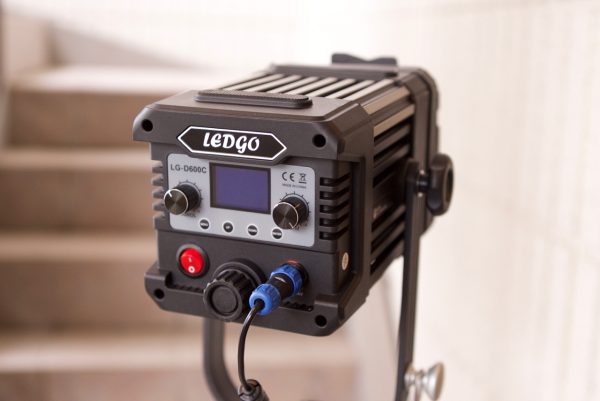
Like a lot of other LED fresnel lights these days, the LG-D600C uses a COB (Chip On Board) LED module. A COB consists of multiple LED chips packaged closely together into one lighting module. This helps to create a single source, instead of the multiple sources you get from LED lights that feature hundreds of individual LEDs. The only drawback with COB technology is that it generates a lot of heat, and that heat needs to be dispersed. Often this means fixtures end up needing a fan – the LG-D600C doesn’t use one though, instead it uses passive heat dissipation to keep the light from overheating.
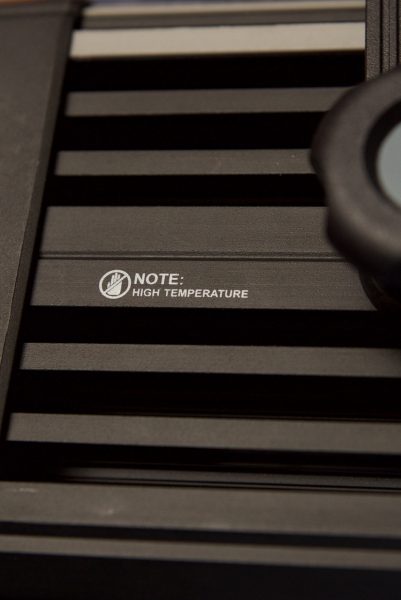
There are lots of open slots all around the light to disperse the heat, but that doesn’t mean the light doesn’t get hot. You don’t want to be touching any area around the vents after you have had the light running for an extended period of time. LEDGO actually puts a warning on the side of the light that says NOTE: High Temperature
LG-D600C: Power draw, battery options
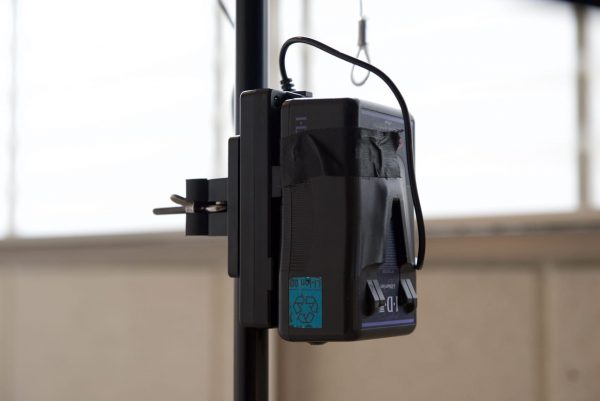
The light draws 60W of power and can be run off a 100-200V mains power source, but if you want to run it off a battery you need to purchase the optional V-lock battery plate. It seems a shame that this is the only option for battery power – on a light that only draws 60W I would have liked to have seen a smaller Sony NP-series battery plate offered as well.
LG-D600C: Dimensions, design and build quality
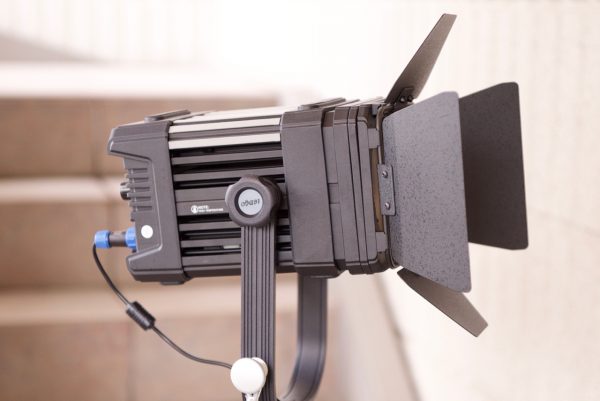
The LG-D600C weighs in at 3kg (6.61lb) with the yoke frame and barn doors attached. The build quality is reasonably good, although I did find quite a few little cosmetic trimming imperfections and variations. This is hardly a big deal, but it’s important to be aware of. The light’s housing is made out of a combination of aluminium alloy and nylon.
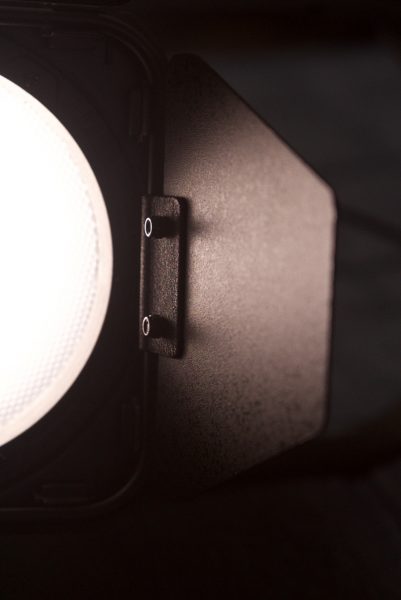
The barn doors are a little on the flimsy side and I’m not sure how they would stand up over time to the rigours of field work. They do fit on nicely though and can be rotated 360 degrees.
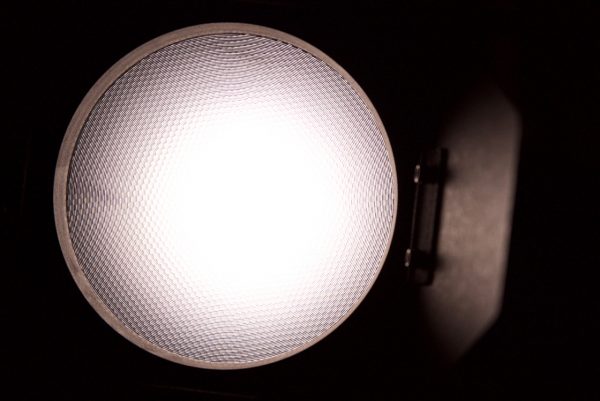
The acrylic fresnel lens looks similar to quite a lot of other lights I have tested, and it is recessed far enough back into the housing that it is reasonably well protected.
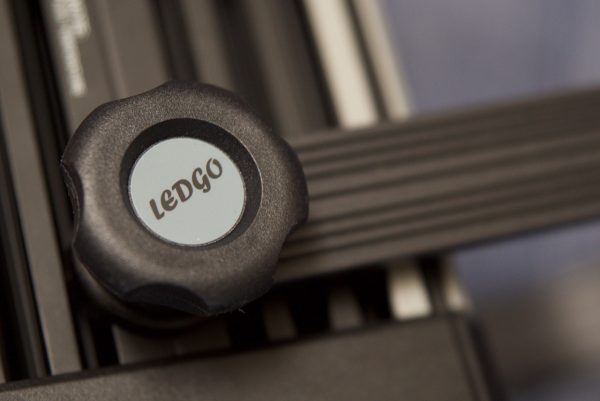
The yoke frame has tightening locks on both sides, which is always nice. It is well made and tightens down securely when locked off. There is also the nice addition of a steel cable that is attached to the frame so you can secure it if you’re using it up in a lighting grid.
LG-D600C: Controls and power supply
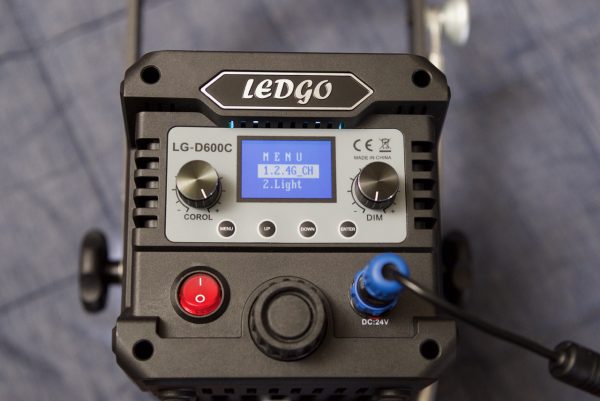
The controls for the light are all on the back of the fixture which is nice and convenient. There are two dials, one for changing the colour temperature (strangely labeled COROL), and the other for increasing/decreasing the brightness. Between those two dials is a LCD screen. This allows you to select the Wifi channel, and you can also see what colour temperature you are set at and what your brightness level is. It is nice to be able to see both the colour temperature and the output level on the same screen.
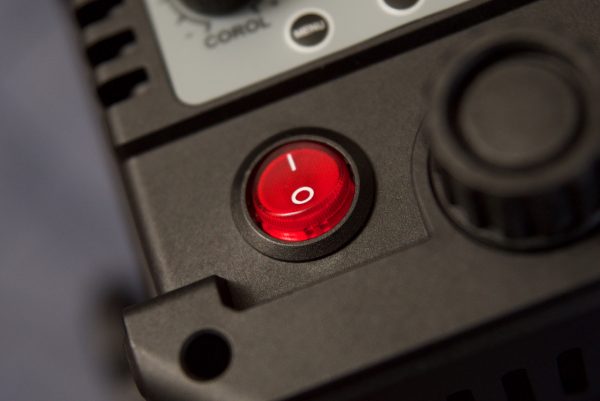
There is a large on/off switch, which is solidly made, as well as a control for spotting or flooding the light. Like almost all other COB-designed LED fresnel lights, the fresnel lens moves away from the COB LED module when you go to spot up the light, and moves back towards it when you go to flood it. The spot/flood dial moves nicely and lets you make very small incremental adjustments.
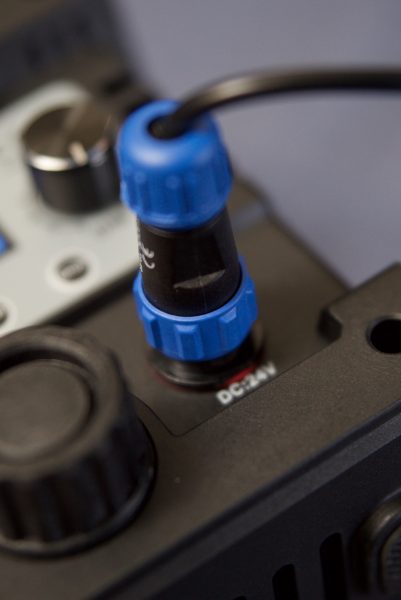
The power connector pushes in and then you twist the barrel to tighten it down, although the actual power cable that goes from the light to the AC power supply is very thin compared to most other lights I have tested.
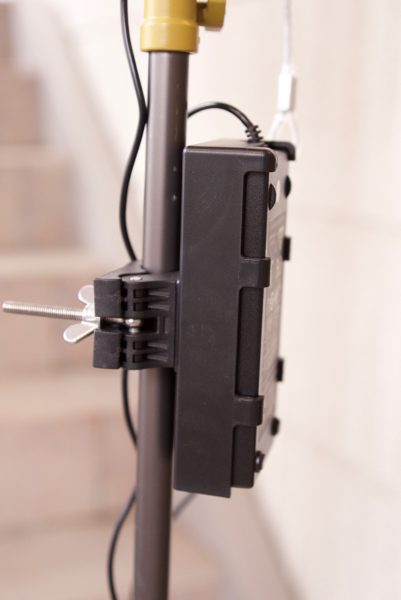
Another nice touch is that the AC power supply sits in a bracket that is designed to tighten around light stands. I wish more manufacturers would think about small things like this. Being able to attach the power supply to a lighting stand securely takes all the strain off the cable. The power supply cable is nice and long, again this is something some other manufactures don’t think of. There is nothing worse than getting a light and finding that you can’t use it without an extension cable, even if your light is placed very close to a AC outlet.
LG-D600C: Wifi control via iOS
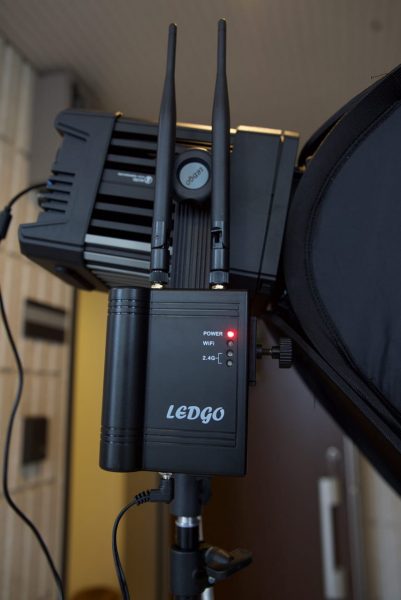
Ledgo offers several optional accessories for the LG-D600C that increase the light’s versatility and usability. The first of these is an adapter module that allows the light to be controlled via Wifi through an iOS app or from a remote control.
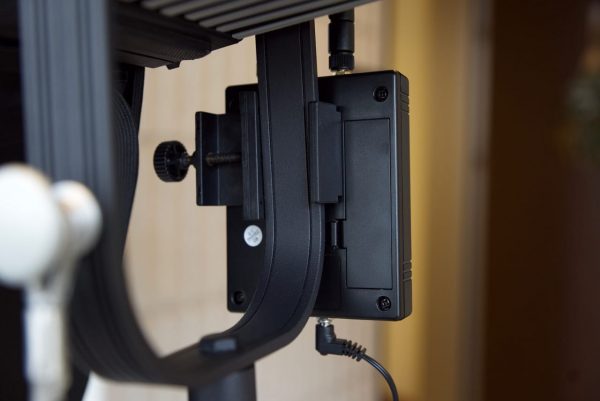
The Wifi module which comes with a nice mounting bracket so you can attach it onto the side of the fixture’s yolk frame. The module doesn’t physically attach to the light with a cable, it just needs to be within 25m of the light to work.
The module itself is a little on the large side but it works really well. To use it all you need to do is turn it on and then choose the Ledgo light in your list of available Wifi networks on your smart device. Your smartphone needs to be within 15m of the Wifi module to work. This gives you quite a lot of distance to work with as you can place the Wifi module 25m from the light and then have your smartphone 15m further back again.
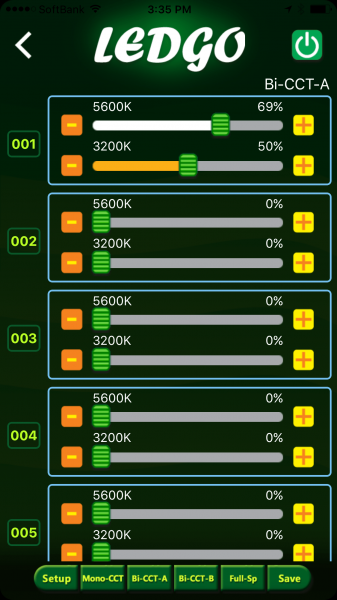
Once it is on you launch the app and then select the same Wifi channel that you have set on the light. From here you can control the colour temperature and the brightness level of the light as well as turn it off and on.
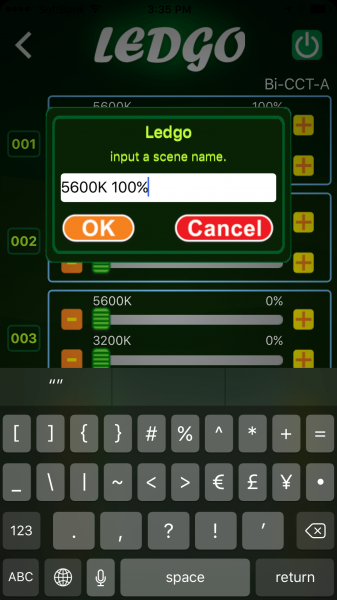
What is also nice is you can save your favourite settings and then recall them by just pressing a single button. You also have the ability to control a huge number of Ledgo lights all at once on the same screen in the app.
There is a slight delay from when you make an adjustment till it actually happens on the light, but it is quite minimal. It is really nice to be able to control a light remotely, especially if you are a solo shooter. The Wifi app allows you to make an adjustment while you are standing at the camera and looking in your EVF or monitor. This saves a lot of time and gives you the ability to make an adjustment when say shooting an interview, in between questions without having to leave the camera.
You can power the Wifi module either through the mains or the DC socket via any 5V-7.5V power source.
LG-D600C: Wifi control via dedicated remote
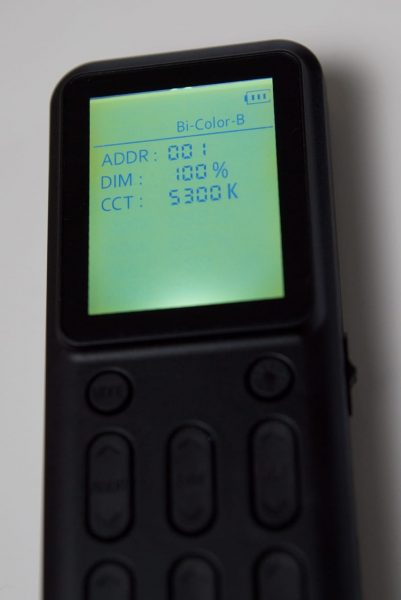
The other option which I personally prefer for controlling the light is with the Wifi remote control. The beauty of using the remote rather than the Wifi module and the app is you only need the remote to control the light. The remote again is a little on the large side but it allows you to have almost the same level of control as the app.
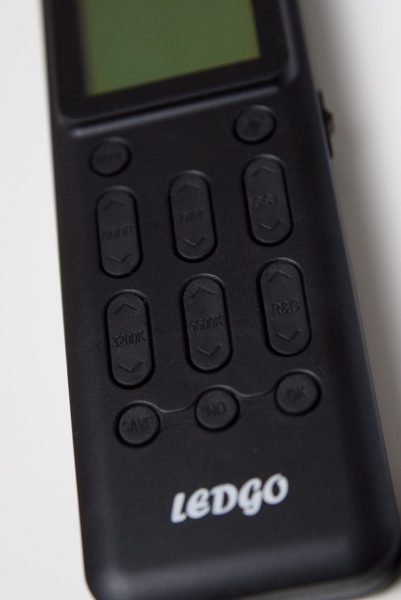
The only negative aspect about the remote control is that the buttons are very badly labelled and are almost impossible to see. On more than one occasion I found myself pressing the wrong buttons on the remote as I couldn’t clearly see what I was doing. Ledgo doesn’t give exact specifications as to how far away the remote controller will work from the light, but I found I was still able to control it over any distance where I would be reasonably using it.
LG-D600C:Optional softbox and egg crate
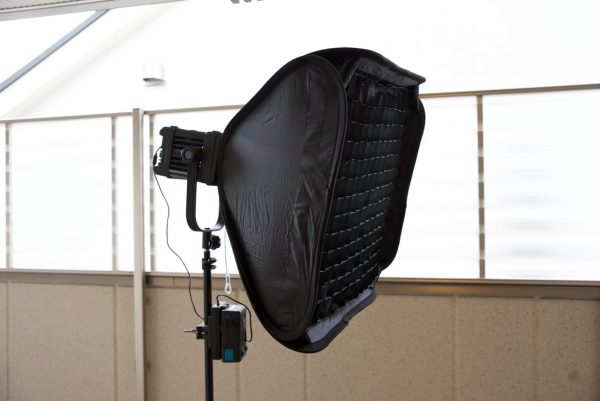
Ledgo also sells a nice softbox and egg crate that you can use to diffuse the light and contain spill when it is in the fully flooded position. The softbox attaches via a Bowens mount which is really easy to put on to the front of the light.
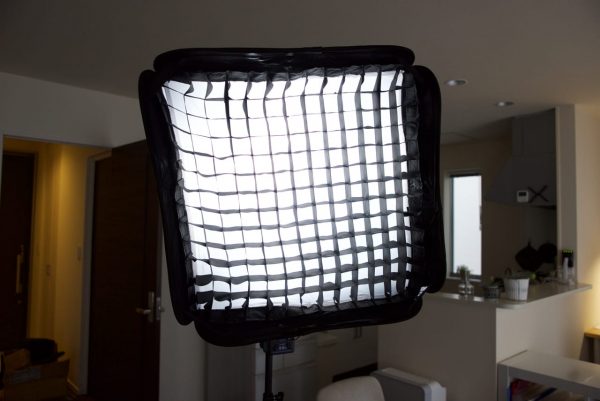
The softbox works well, but as the light doesn’t have a huge output i found it wasn’t really that useable for interviews as it diffused the light too much and didn’t provide me with a strong enough source.
LG-D600C: Diffusion hoods
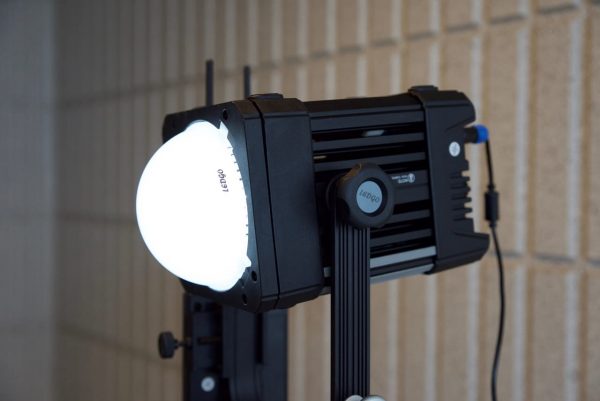
Also available are a range of diffusion hoods that just clip into the Bowens mount. These are nice and easy to use and allow you to create a much wider light source.
LG-D600C: Photometrics
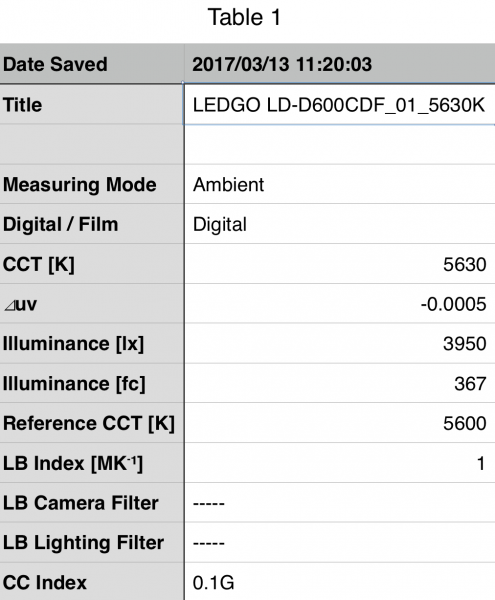
I tested the LG-D600C with a Sekonic C700 to see what sort of output the light had. If you don’t want to read all the details you can skip ahead to the summary. When set at 5600K in the full flood position (50°) the light registered 3950lx at a distance of 1m (3.28ft). It had a Kelvin temperature of 5630K, and a ⊿uv score (⊿uv is the value to show how much this light is away from being an ideal light source (black body radiation = incandescent lamp) of -0.0005. These results showed me that the light was very good at replicating a 5600K light source.
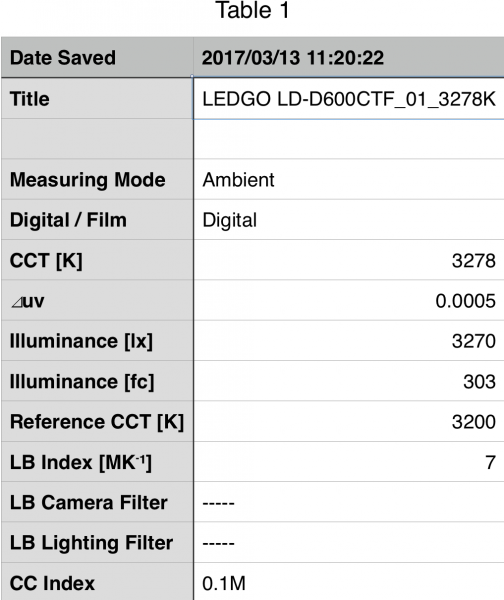
When I tested the light in the same flood position (50°), but this time at 3200K I got the following results: The light registered 3270lx at a distance of 1m, and it recorded a Kelvin temperature of 3278K. The ⊿uv score was 0.0005. It is nice to see that the light is extremely consistent when it comes to producing accurate Kelvin temperatures regardless of whether it is set at 3200 or 5600K. The output of the light when set at 3200K compared to 5600K was around 20% less.
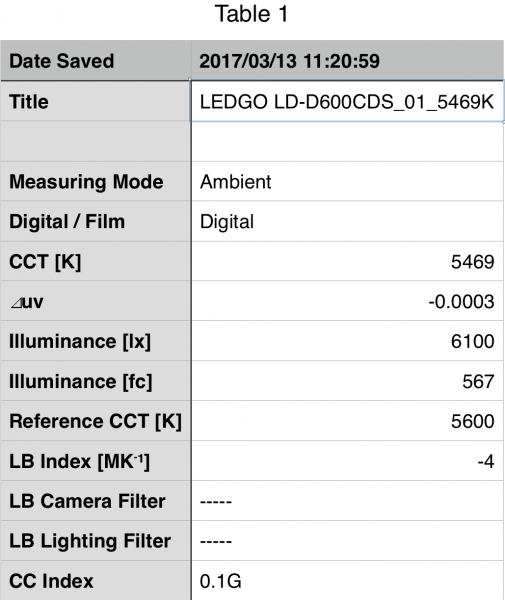
I then tested the light again at 5600K, but this time in its full spot position (15°). I got the following results: The light registered 6100lx at a distance of 1m (3.28ft). It recorded a kelvin temperature of 5469K, and had a ⊿uv score of -0.0003. The output from flood to spot increased by around 55%.
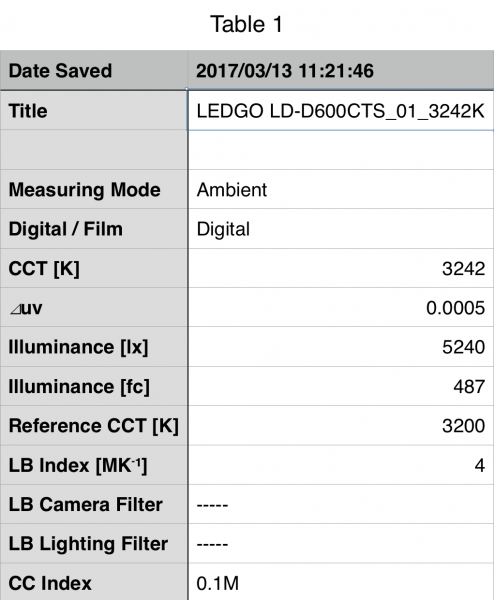
When I tested the light in the full spot position set at 3200K I got the following results. The light registered 5240lx and recorded a kelvin temperature of 3242K. It had a ⊿uv score of 0.0005. Again the light showed a similar decrease of around 20% in output when set at 3200K compared to 56600K. The results showed that the light is very colour accurate when set in both the flood and spot positions regardless of what colour temperature is being used.
In summary:
Output
5600K (flood position)- 3950lx
5600K (spot position)- 6100lx
3200K (flood position)- 3270lx
3200K (spot position)- 5240lx
Kelvin temperature
5600K (flood position)- 5630K
5600K (spot position)- 5469K
3200K (flood position)- 3278K
3200K (spot position)- 3242K
LG-D600C: Colour rendering
The light is very Kelvin colour accurate, but how does it fare when it comes to colour rendering scores? Again I tested the LG-D600C with a Sekonic C700 to find out.
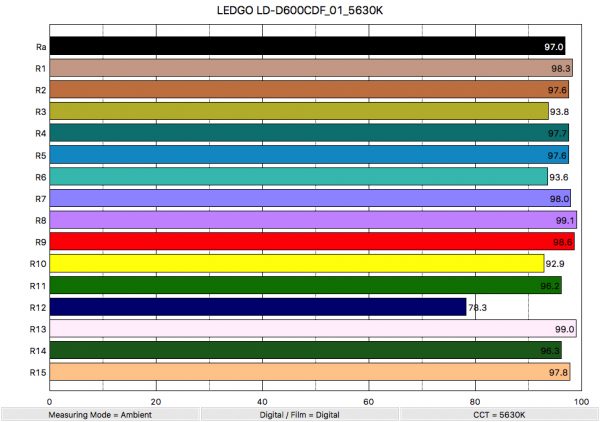
Above you can see the colour rendering scores for the light when it was set at 5600K in its full flood position. The light recorded an average CRI (R1-R8) of 97, and an extended CRI (R1-R15) of 95.65. For rendering skin tones accurately it registered 98.6 for R9 (red), 99 for R13 (closest to caucasian skin tones), and 97.8 for R15 (closest to asian skin tones). These results were extremely good and the light was exceptionally good when it came to replicating skin tones accurately.
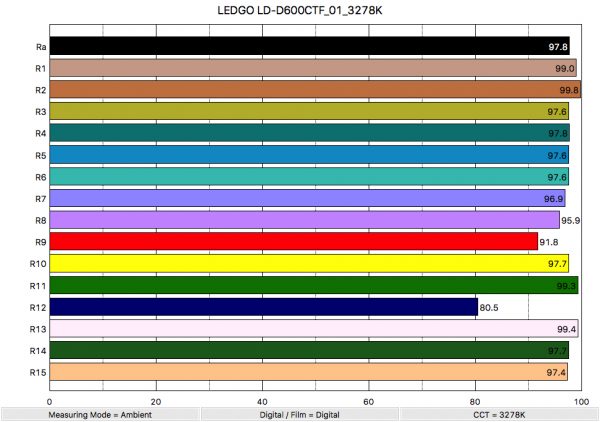
I tested the light again at 3200K in the full flood position and got these results. The light recorded an average CRI (R1-R8) of 97.8, and an extended CRI (R1-R15) of 96.4. For rendering skin tones accurately it registered 91.8 for R9 (red), 99.4 for R13 (closest to caucasian skin tones), and 97.4 for R15 (closest to asian skin tones). These results were again extremely good and the light was also very good when it came to replicating skin tones accurately. What was also nice to see was that the light was very consistent whether it was set at 5600K or 3200K.
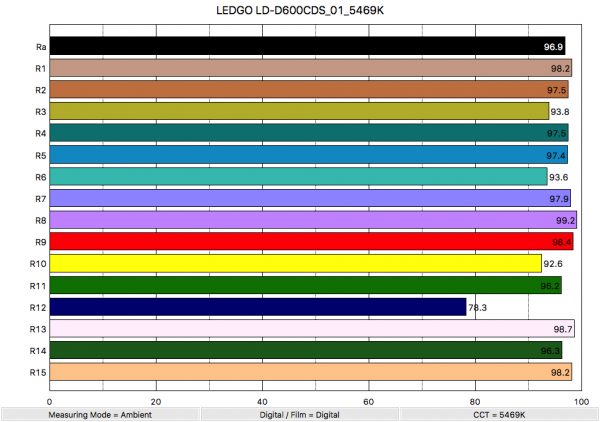
I also tested the light in its full spot position at 5600K. It recorded an average CRI (R1-R8) of 96.9, and an extended CRI (R1-R15) of 95.58. For rendering skin tones accurately it registered 98.4 for R9 (red), 98.7 for R13 (closest to caucasian skin tones), and 98.2 for R15 (closest to asian skin tones).
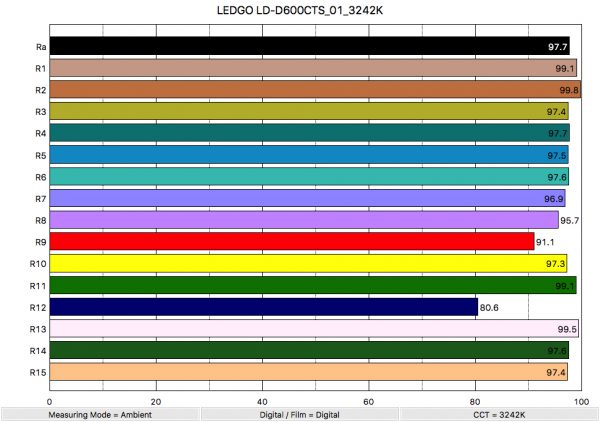
In its full spot position when set at 3200K it registered an average CRI (R1-R8) of 97.8, and an extended CRI (R1-R15) of 96.28. For rendering skin tones accurately it registered 91.1 for R9 (red), 99.5 for R13 (closest to caucasian skin tones), and 97.4 for R15 (closest to asian skin tones).
In Summary:
EXTENDED CRI (R1-R15)
5600K (flood position)- 95.65
5600K (spot position)- 95.58
3200K (flood position)- 96.4
3200K (spot position)- 96.28
R9 (RED)
5600K (flood position)- 98.6
5600K (spot position)- 98.4
3200K (flood position)- 91.8
3200K (spot position)- 91.1
R13 (CLOSEST TO CAUCASIAN SKIN TONES)
5600K (flood position)- 99
5600K (spot position)- 98.7
3200K (flood position)- 99.4
3200K (spot position)- 99.5
R15 (CLOSEST TO ASIAN SKIN TONES)
5600K (flood position)- 97.8
5600K (spot position)- 98.2
3200K (flood position)- 99.4
3200K (spot position)- 97.4
I was extremely impressed with the consistency of the light no matter whether it was set at 3200K or 5600K, or whether it was spotted or flooded. The light surprised me with just how good it’s scores were, especially for an affordable bi-colour fixture.
LG-D600C: In use, and the competition
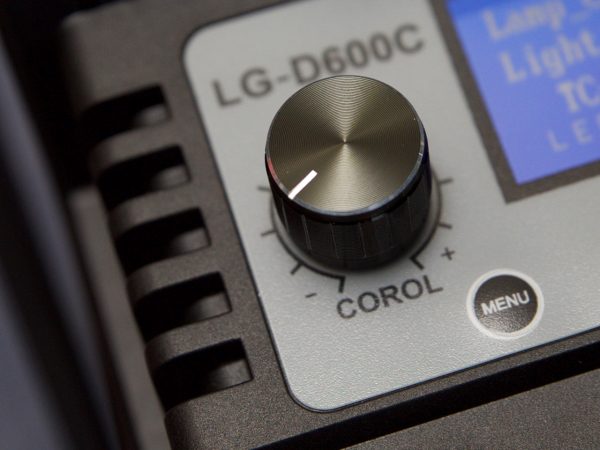
So how is the light to actually use? The LEDGO LD-D600C is very straightforward to set up and operate. The one small thing I did find is that even though there are markings on the colour temperature dial, there are also notches in between, where if you move the dial to that position the Kelvin temperature read out doesn’t change. For example if the dial is set at 4500K, there are 3 knotches on the dial before it reaches 4600K. It’s not that these three notches don’t do anything, it’s just that you don’t see any Kelvin temperature read out change. The notches are actually increases of around 250K (I measured this with a Sekonic C700). It is a pity that you can’t see this setting change off the display screen.
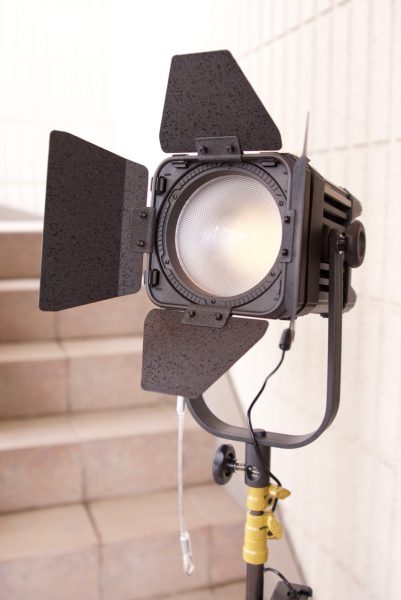
It’s hard to say just how the LEDGO LD-D600C compares to its competition, as there aren’t that many other lights you can directly compare it to. There are almost no other bi-colour LED fresnel lights with such a low power draw. If there was any competition it would have to be from the Kinotehnik Practilite 602 Smart LED Fresnel, but it draws 90w, not 60w like the LEDGO. The Fiilex P360EX Variable Colour LED Light is another option, but you need to add an optional fresnel lens to give it similar functionality. It also draws 90w, just like the Kinotehnik.
Although it’s not bi-colour, the CAME-TV Boltzen 55w daylight fixture is also an alternative. When I tested it with the CTO gel it comes with it was capable of producing a fairly colour accurate 3200K source, but at the expense of quite a large loss in output.
LG-D600C: final thoughts, price and availability
The LEDGO LG-D600C is quite unique, and it certainly has its share of strengths and weaknesses. While it produces a nice colour accurate source, it really isn’t that powerful for a light that is this size and that weighs 3kg. Unfortunately you can’t make a COB fresnel LED light much smaller if you also want to have it colour adjustable. For travelling shooters, the size and weight has to be weighed up against the output. With the optional accessories such as soft boxes and the fact that it has such a low power draw, it certainly could be used as an all-in-one light if you could only travel with a small kit.
The optional accessories are really nice and I was quickly won over by the ability to control the light remotely via Wifi. I like the LEDGO LG-D600C, it has a nice feature set and the light’s colour accuracy is certainly its biggest strength – but I just wish it had a bit more output. The LG-D600C will be available soon for $780 US. If you live in the USA, the distributor is the Interfit company





